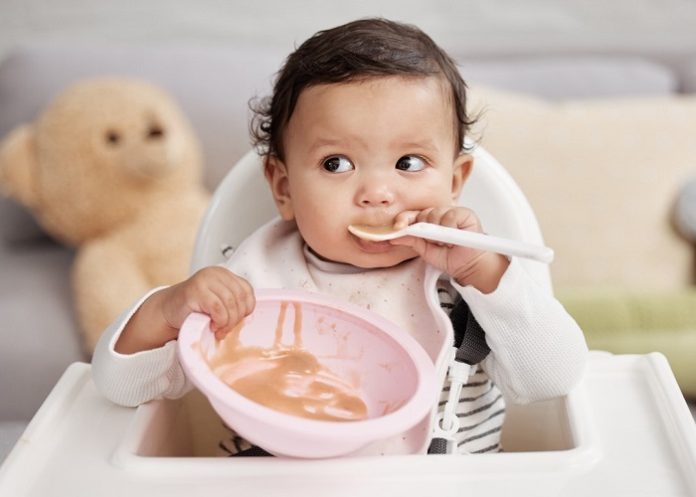Researchers from Stellenbosch University have called for infant food flavourings to be evaluated and for labelling regulations to be strengthened and enforced after their study found that a number of packaged products contained flavourings that could harm children’s health, reports TimesLIVE.
The flavourings in these foods – also called commercial complementary foods (CCFs) – need to be re-assessed, they urged.
In the study published in the journal Maternal and Child Nutrition, the team created a profile of flavourings added to CCFs, focusing on their prevalence and type (taste, flavour and nature).
By photographing product labels and contacting manufacturers, the researchers looked at CCFs for babies and young children aged six to 23 months, available in supermarkets, pharmacies and baby shops nationwide.
Most of the products included in the study were manufactured in South Africa, while the rest were imported.
Only half of the CCFs complied with South African labelling regulations relating to flavourings, and more than three-quarters (78.3%) violated regulations relating to non‐addition claims, they found.
Non-addition claims are statements that say a certain ingredient – usually one that’s commonly added to similar foods – has not been added to the product.
They found that most of the CCFs are sweet and high in sugar, with many containing added sugar to appeal to babies’ and young children’s natural preference for sweetness.
“This sort of marketing may result in children developing a preference for certain flavours over acceptance of the specific foods,” they wrote.
On their findings, the researchers said:
• About a third (36.2%) of CCFs contained flavourings, with just more than three-quarters (75.9%) of these containing one and the remainder up to three flavourings.
• 84% of baby cereals and porridges contained flavourings.
• The flavourings in CCFs were primarily sweet (more than 80%), with vanilla the most prevalent flavour. Other flavours include caramel, chocolate, honey and rooibos.
• Almost half (48.6%) of the baby drinks, all labelled as suitable for babies six months and older, contained flavourings.
The researchers called attention to the issue of misleading marketing of CCFs.
“While all flavourings containing CCFs indicated flavourings correctly in their ingredient lists, a small percentage of CCF names and/or descriptors were misleading to parents and carers by implying the products contain certain real ingredients, not just flavourings of these ingredients.”
They emphasised the need to enforce national regulations relating to food for infants and young children, which explicitly prohibit any health, medical or nutrition claims for these products.
“Strengthening these regulations and their enforcement would help ensure infants and young children are provided with safe, nutritious and appropriately labelled food options,” they noted.
“We also need stronger national mechanisms to ensure manufacturers fully comply with all aspects of food safety regulations.”
Because South Africa is a key trade gateway, the researchers say their findings also apply to neighbouring African countries.
Study details
A profile of flavourings in commercial complementary foods in South Africa
Wilana Barnard, Lisanne Monica du Plessis, Gunnar Oliver Sigge.
Published in Maternal & Child Nutrition on 7 July 2025.
Abstract
Research into the sugar content of commercial complementary foods (CCFs) for infants and young children (IYC) has been extensive, but little attention has been given to flavourings in these products. This study aimed to create a profile of the prevalence and type of flavourings in CCFs for IYC in South Africa (SA). Data were collected on CCFs indicated as suitable for introduction from ages 6 to 23 months at 26 physical stores in the Western Cape, and the online stores of nine major SA retailers between June 2022 and February 2023. Data were collected by photographing product labels and contacting the manufacturers for further information. The results showed that 36.2% of CCFs contained flavourings, with 75.9% of these containing one and the remainder up to three flavourings. More than half (52.4%) of the flavouring-containing products were marketed as suitable for introduction from 6+ months, and almost half (48.6%) of the baby drinks, all indicated as suitable for introduction from 6+ months, contained flavourings. Flavourings were present in 84.2% of dry baby foods (cereals/porridges). The flavourings in CCFs were primarily of sweet flavours (> 80%) with vanilla being the most prevalent flavour. Moreover, only 51% of CCFs complied with all SA labelling regulations relating to flavourings and 78.3% violated regulations relating to non-addition claims. The prevalence of sweet CCFs with added flavourings raises concerns about its potential negative impact on children's taste preferences, dietary habits, and consequent long-term health outcomes. Re-evaluating the use of flavourings in CCFs and strengthening the enforcement of labelling regulations in SA is imperative.
TimesLIVE article – Sugary flavours are spoiling infant food (Restricted access)
See more from MedicalBrief archives:
Nestlé to end sugar addition in baby products from year-end
Healthy Living Alliance: Study on political strategies of SA's food and beverage industry

